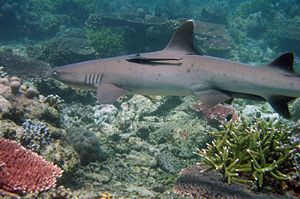Protected areas show ravaged reefs can recover
Most coral reefs located in Philippine waters are under dire threat, save for three marine habitats that serve as havens for fish, whales and dolphins and replenish the country’s lost sea riches.
Tubbataha Reef in Palawan, Apo Reef in Occidental Mindoro and Sarangani Bay in Mindanao are examples of how effective management of marine protected areas (MPAs) can dramatically improve ravaged reef conditions, Environment Secretary Ramon Paje has said.
According to the Department of Environment and Natural Resources (DENR), the most potent way of managing coral reefs is to let them be.
MPAs are regions where human activities are restricted to a minimum to allow for the conservation of the natural environment and ecosystems of the area, the DENR said.
“Improved MPA management, therefore, reduces human pressures on the marine environment and allows coral reefs and other forms of marine life to recover and replenish themselves,” Paje said.
Article continues after this advertisementThe Philippines hosts about 1,000 local MPAs—patches of coral reef or sea grass beds that are protected in various degrees by law—the World Wild Fund for Nature (WWF)-Philippines said.
Article continues after this advertisementTubbataha Reef, Apo Reef and Sarangani Bay, along with about 30 other areas, have been designated national MPAs under the National Integrated Protected Areas System, which lays out the ground rules for the management of protected areas, including stringent penalties against violators.
“This has boosted fish diversity, as well as enhanced the fisheries contribution at an annual rate of 10-30 tons of fish per square kilometer of reef in the area,” Paje said.
Recent DENR studies have shown that the three MPAs, which have each enjoyed protected status for several years, produce greater fish densities and healthier fish populations, Protected Areas and Wildlife Bureau (PAWB) Director Mundita Lim said.
“Even though they are protected, there is still fishing in these areas, but there are restrictions which are set by the local government and other stakeholders,” she said.
She said the DENR was studying commonalities among Tubbataha Reef, Apo Reef and Sarangani Bay in order to determine the best practices in managing MPAs.
At Tubbataha and Apo, for instance, Lim noted that their strategies were geared towards improving facilities and pouring resources into ecological tourism. Fisher folk there are earning more income because of tourism, she said.
To ‘replicate success’
In Sarangani Bay, the fisheries sector has been strengthened with seascape managers in close coordination with the Bureau of Fisheries and Aquatic Resources to boost tuna populations in the traditional fishing grounds.
The goal, Lim said, is to replicate the success of the three in other provinces with poor reef management systems. “Next year, we will come out with the Protected Area Awards which will recognize the best managed protected areas,” she said.
The WWF identified three effective practices in administering MPAs: deployment of patrol guards against illegal fishermen; use of renewable sources of energy, such as solar panels; and proper solid waste management along the coastline.
Tangible results
The nongovernmental organization cited as a “model for every ecotourism development in the Philippines” its partnership with Costa del Hamilo in the management of three coves—Santelmo, Etayo and Pico de Loro in Batangas.
The coves “are continuously protected, and the results speak for themselves—improved fish yields, more reef fish, the regrowth of corals,” Gregg Yann, WWF’s communications and media manager, said.
Since most of the country’s MPAs are managed by local government units, policies in enforcement, funding and other management issues are often affected by shifting priorities, especially when there is leadership change after elections, Paje said.
This is where civil society and other stakeholders can do their share, he said.
Paje said the participation of civil society was necessary to replicate the successes of Tubbataha Reef, Apo Reef and Sarangani Bay.
In a statement in July, he called on local fisher folks, the tourism, fishing and aquaculture industries, the academe, conservation organizations, and water hobby or sports organizations to participate in managing MPAs.
World Heritage site
The Tubbataha Reefs Natural Park, which has been declared a World Heritage site by the United Nations Educational, Scientific and Cultural Organization (Unesco), lies at the center of the Sulu Sea. Including the Jessie Beazley Reef, it protects almost 100,000 hectares of high quality marine habitats containing three atolls and a large area of deep sea.
The park is home to whales, dolphins, sharks, turtles and Napoleon wrasse and supports over 350 species of coral and almost 500 species of fish. The reserve also protects one of the few remaining colonies of breeding seabirds in the region, Unesco said.
Sarangani Bay, on the other hand, encompasses an area of 449 square kilometers that features several coral reefs and reef fish communities, according to a 2001 study by the DENR.
Almost 200 species of fish have been observed in the area, and it is frequented by marine mammals like dolphins and sharks, including the whale shark, the study said.
